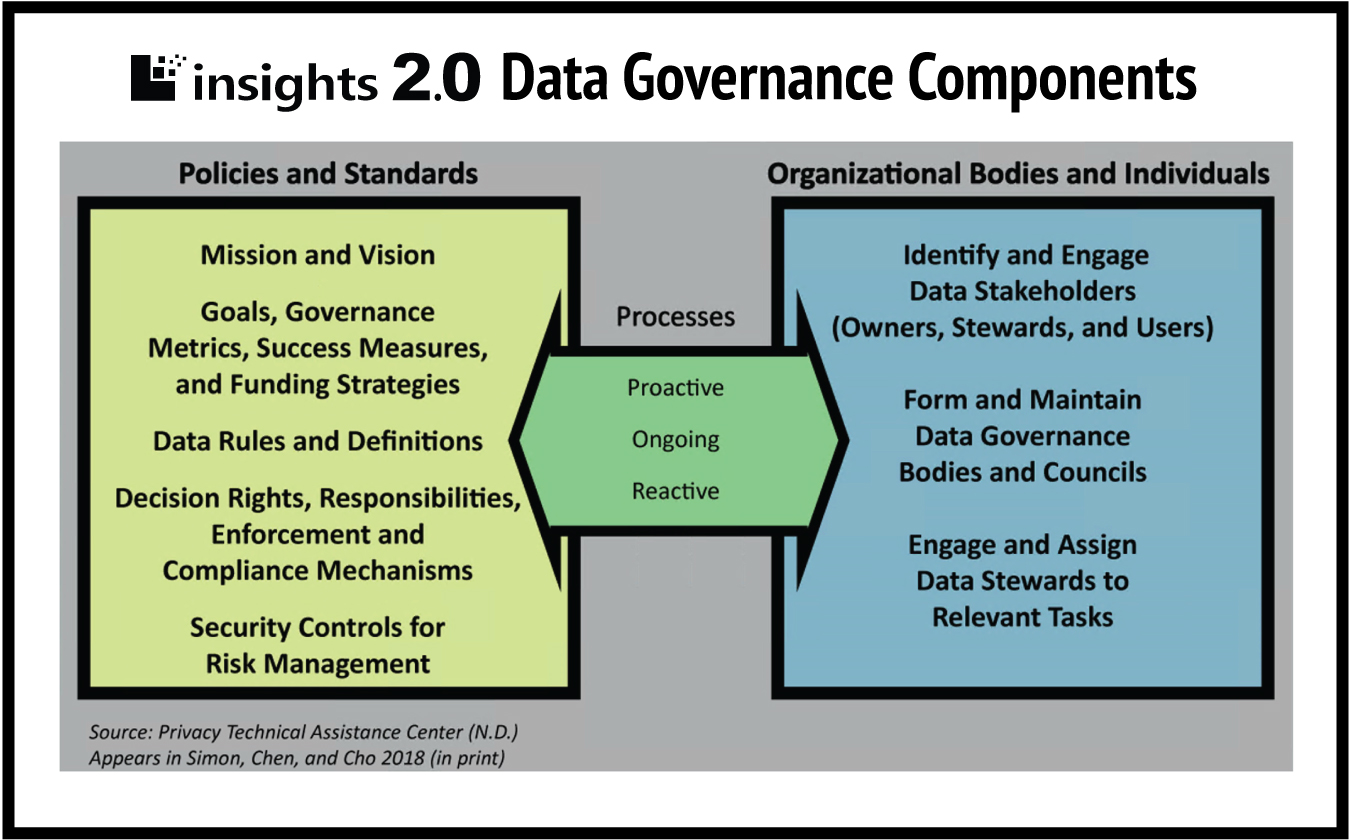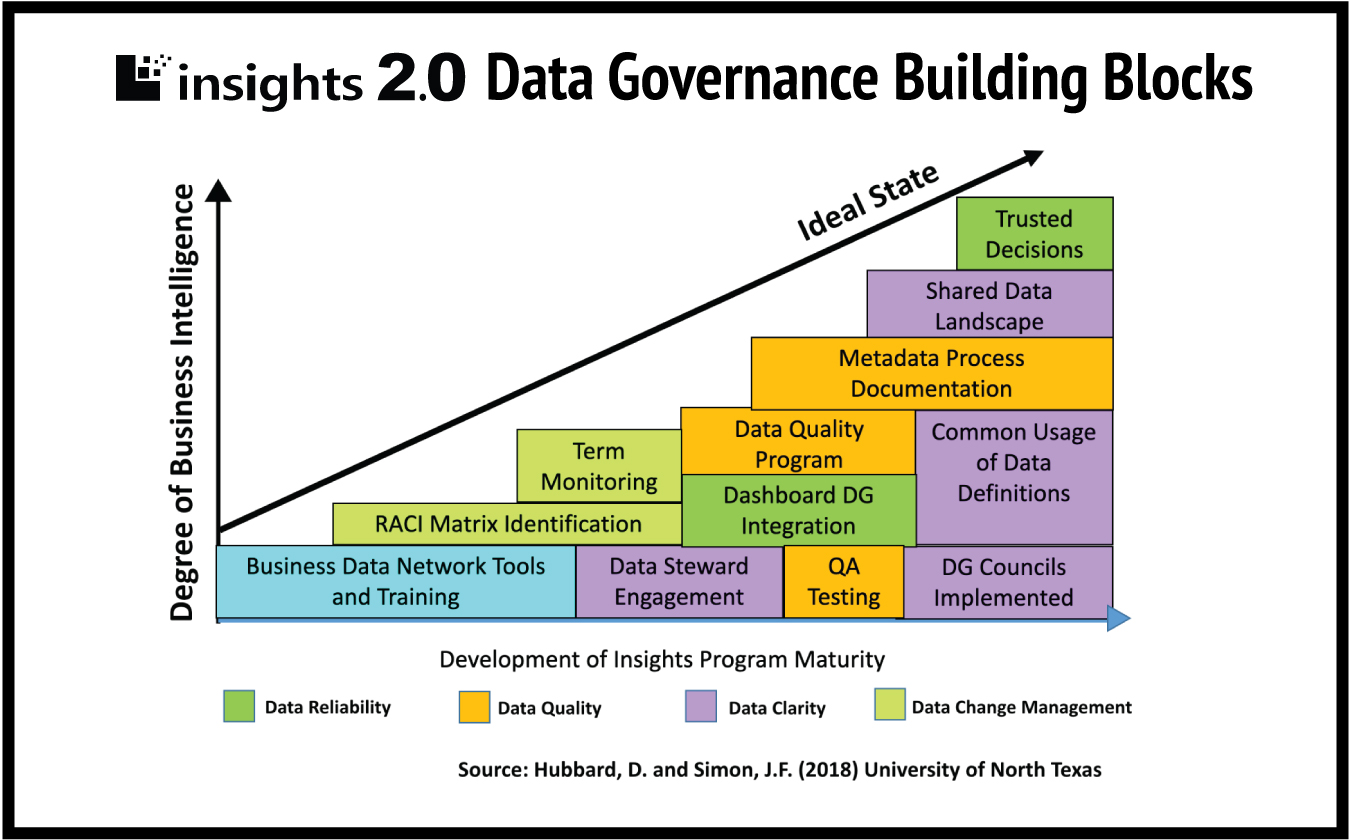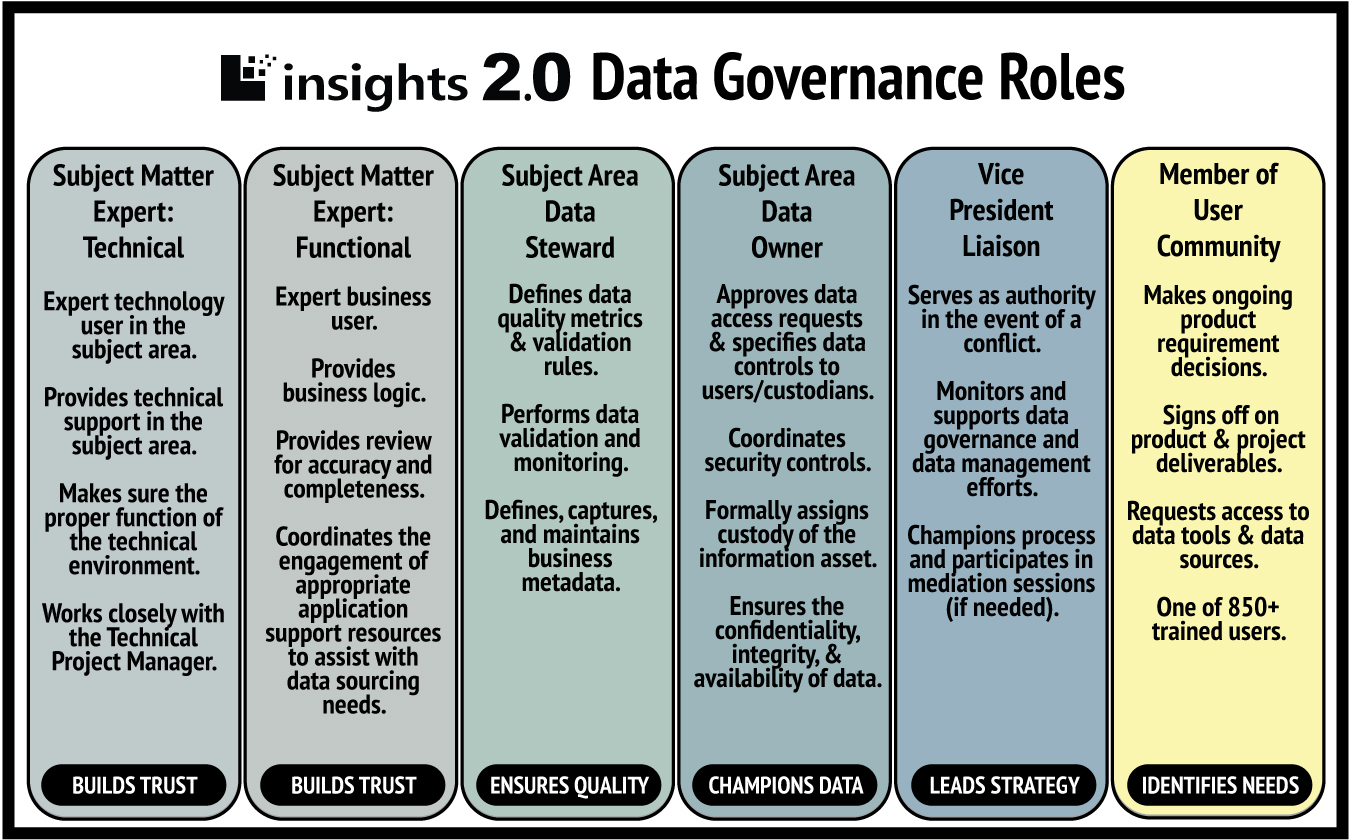NOTE: If you are visiting this site from an external institution of higher education or other organization and utilize any of the content here please attribute the UNT Insights program and email insights@unt.edu to alert us.
What are the required components for an effective Data Governance program?
Insights 2.0 developed our program following the guidelines of the Federal Privacy Technical Assistance Center. As you will read below these components manifested themselves into the structures, tools, and processes we use today. It is important for our community to understand that these are vital components to ensuring trusted and secure data assets.

How did Insights 2.0 proceed to build out the required Data Governance elements?
Insights 2.0 believes that the true power of data governance is the ability for decision makers to use trusted data to make decisions. Data that is not governed can be viewed with suspision and distrust. Insights 2.0 leverages this philosophy to approach the important work of analytics. The following image helps our community understand the required building blocks for an effective data governance program.

What roles are involved in the Insights 2.0 Data Governance program?
Effective programs require bottom up involvement and top down leadership for success. Insights 2.0 protocols engage a diverse audience of professionals throughout the enterprise. The following roles and responsiibilities are utilized within the Insights 2.0 program.

What are the Data Governance Objectives for the Insights 2.0 Program?
- Maintain a correct and consistent definition of the data and its business rules.
- Develop a regular and routine protocol to review existing definitions to ensure their ability to accurately reflect campus needs.
- Increase the consistency, availability, usability, and quality of internal and external data.
- Develop a well informed and comprehensive data dictionary/metadata repository for data elements utilized in delivered products.
- Eliminate redundant or conflicting business processes and practices.
- Define, communicate, and re-assess data governance outcomes and metrics for success
- Provide a solid framework that enables sustainable execution across multiple data domains (student, financial, academic, etc.).
- Deploy a holistic array of data governance toolsets to build toward a culture of transparency.
What are the Data Governance Principles that Guide the Insights 2.0 Program?
- Our data will serve as a catalyst to help our institutions succeed.
- Data will be treated as a valuable institutional asset.
- Elevating data quality will be a shared responsibility.
- Data governance is a hands-on activity worthy of our time.
- Systems and toolsets will undergo a data governance review prior to implementation.
- Data is a shared commodity utilized by a broad spectrum of constituents.
- Data governance practices will be transparent.
- We will measure ourselves on our progress.
What does our community need to know about our Philosophy of Data Governance?
We Require All Products to Undergo a Data Governance Process
Insights 2.0 is committed to two important premises: First, no analytic dashboard will be released without being fully documented and governed. Second, institutional data is exposed as it exists in the source system. By intentionally engaging our technical and functional subject matter experts in a governance process we help our users have confidence in the information they are seeing. Insights 2.0 users never have to wonder where data is coming from or how it was exposed. Rather, our process ensures that multiple stakeholders from across the enterprise can play critical roles in the management of our institutional data assetts.
We Leverage the Strengths of Executives and Subject Matter Experts in Our Governance
Process
Past UNT President, Dr. Neal Smatresk, was responsible for the charge that initiated
the development of our data-warehousing, governance, and analytics program. Because
of his engagement, UNT is able to more efficiently deliver accurate, timely, and dynamic
data resources with documentation into the hands of our decision-makers. Additionally,
our Cabinet members also champion the goals of the program and are willing to support
data governance efforts. Our functional subject matter experts ensure that data is
presented in alignment with commonly understood business logic. Our technical subject
matter experts ensure that we have appropriate documentation around the physical or
virtual location of the data structures within the larger enterprise-wide data ecosystem.
Finally, our team of data modelers, institutional researchers, and data management
practitioners all contribute to ensuring that data presented is focused on helping
our users and institution solve challenges.
We Celebrate Milestones in our Governance Process
DAIR and our partners are committed to celebrating Insights successes. From releasing
our first dashboards, to training our first user, to surpassing milestones in dashboard
production and the amount of data that is documented, we applaud successes and our
champions who helped us get there. We know that the tools and technology, by themselves,
won't help UNT succeed. Rather, we focus on people, and highlight those who have joined
in the process to evolve our institution's data landscape.
We Encourage Data Analytics and Governance Evangelists
We believe that data governance and analytics are inseparable. We understand that
it would be foolish to expend the effort to build fancy analytics or reports if there
is no common understanding about what should be shown? The beauty of Insights 2.0
is that it is built upon self-service analytics. This feature allows users to access
dynamic information to meet their needs on their own timeline. That being said, the
kiss of death for any analytic tool occurs when it is understood differently by multiple
users. Within our Insights 2.0 ecosystem we focus our conversations with our users
around the value of data governance to promote data reliability and consistency.
We Make Data Governance Transparent to Users
Insights 2.0 leverages SAS Business Data Network (also known as BDN) to offer our
users a consistent and attractive portal to learn about our data and the information
about it. BDN is accessible from every Insights 2.0 product and users can easily link
to our external data governance portal to better understand the data they are seeing.
BDN allows our users to learn more about business logic, metadata (data about the
data), and where a particular data element may live in relation to other datapoints
and data structures. BDN is easy to navigate, intuitive, and serves as the backbone
for our data governance effort.
We Leverage Industry-Leading Data Governance Tools
We know tools matter at UNT. We also know that we must provide training and support
in our data-governance tool. We believe in the value of having a data-governance tool
that defines data frees up time and effort that would have been spent working in a
data-governance committee. We hear from colleagues across the country too many stories
from their institutions who require staff to sit in a room for hours in order to define
individual terms. Rather, because of Insights 2.0 use of BDN, SMEs and data stewards
can contribute to an online repository independently—on their own time. Giving them
access to the systems and resources they need while they contribute technical and
functional documentation is a powerful contributor to our program's success. UNT's
use of our vendor's abilities in this area contributed to ensuring that data governance
was a foundational first step for the rest of the program.
We Track Progress and Set Goals for our Data Governance Program
Data-governance tools are typically great repositories for term documentation and
metadata, but the built-in reporting functionality usually leaves a lot to be desired.
Insights 2.0 developed a reporting method that allows the team to output and monitor
data term review information. We also produced a business term dashboard to track
progress and set goals related to business term review. We use this to communicate
with administrators about outstanding documentation and needed term revisions and
allows us to track and celebrate progress as we continue to document and define a
greater portion of our institutional data resources.
We Link Data Governance with Data Modeling and Analytic Production Efforts
In building a data-warehousing, governance, and analytics program, we found that members
of our data-modeling and analytics teams had to work across the institution as they
developed accurate, validated data models to feed analytic tools. In order to meet
the needs of our users, we partnered with over 30+ SMEs and data stewards to understand
our data resources and build key data structures. Forming relationships with our key
data-governance representatives provided the perfect opportunity to grow our capacity
in data governance and this linkage remains strong today. UNT could now demonstrate
how our analytic tools and their integration with our data-governance program best
served the institution. We were able to provide the documentation for all data elements
used in data models and analytic deliverables. UNT intentionally takes every opportunity
possible to work with key technical and functional SMEs to maximize our overall capacity
for thorough documentation and trusted governance protocols. These collabortions serve
as a foundation for our data governance efforts.
We Challenge Ourselves to Use Data Governance as a Vehicle to Eliminate Institutional
Silos
To become successful, UNT intentionally utilized the governance and documentation
process to break down data silos within UNT. Data governance, by definition, forces
us to identify our data stewards and key SMEs responsible for the technical and functional
implementation of data structures. We believe that our efforts to promote the idea
that data governance needs to take place within small, functionally based groups were
a key to our success. However we also developed, in parallel, structures to resolve
differences in the definition, understanding, and usage of key business terms. This
process created intentional conversations that clarified long-standing business confusion.
By refusing to do data as normal, UNT was able to leverage the strengths of our SMEs
without the consequence of further isolating our existing silos of excellence.
We Maintain our Commitment to Data Governance but are Flexible with Roll-out and Timelines
At UNT, our first priority as a higher education institution is to recruit, enroll,
retain, and graduate students. Through our team's work, our staff relies on the UNT
mission, which calls upon us to provide education to change the lives of the students
and families we serve. We leverage this belief to recontextualize the importance of,
and our commitment to, data governance. That being said, we know there are times when
functional areas simply cannot invest the bandwidth to prioritize data-governance
work. UNT bridges this gap by adhering closely to the commitment to data governance
and documentation and, by extension, continuously championing and supporting data-governance
efforts under an overall philosophy of demonstrating flexibility with specific timelines
and target dates.